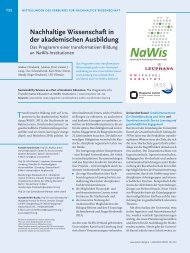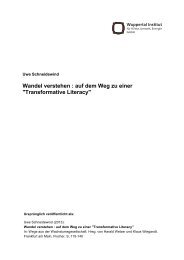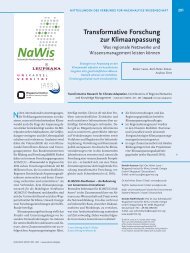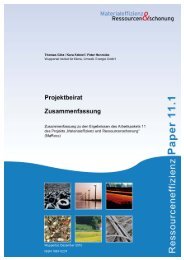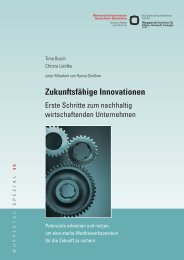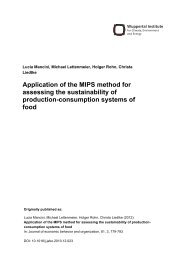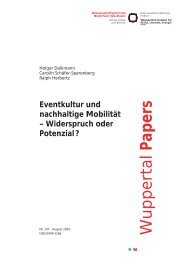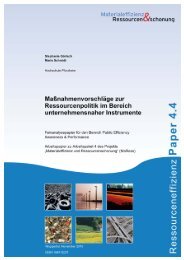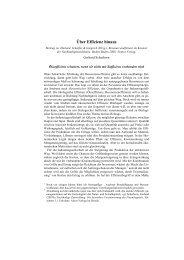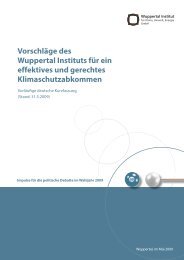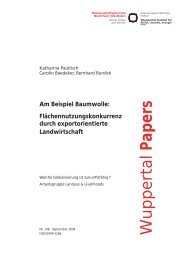Resource Efficiency Atlas - Publication Server of the Wuppertal ...
Resource Efficiency Atlas - Publication Server of the Wuppertal ...
Resource Efficiency Atlas - Publication Server of the Wuppertal ...
You also want an ePaper? Increase the reach of your titles
YUMPU automatically turns print PDFs into web optimized ePapers that Google loves.
70<br />
Chapter 4: Strategic starting-points for more resource efficiency<br />
Opportunities<br />
Which opportunities arise from development <strong>of</strong> resource<br />
efficient technologies and products?<br />
Improved environmental impact<br />
<strong>Resource</strong> savings tend to reduce multiple environmental impacts<br />
(e.g. reduction <strong>of</strong> land use intensity, material and water<br />
savings, reduced greenhouse gas emissions).<br />
Exploiting potentials for cost savings across different sectors.<br />
<strong>Efficiency</strong> potentials exist in branches <strong>of</strong> production with<br />
high resource use (e.g. construction industry, energy supply).<br />
Competiveness <strong>of</strong> Germany<br />
The development <strong>of</strong> resource efficient products streng<strong>the</strong>ns<br />
Germany’s dominant position in <strong>the</strong> field <strong>of</strong> environmental<br />
technologies<br />
The export <strong>of</strong> resource efficient technologies can act as a<br />
growth engine and creation <strong>of</strong> attractive and long-term<br />
employment.<br />
Lowering <strong>the</strong> dependency on resource rich countries.<br />
Responsibility for future generations<br />
Preservation <strong>of</strong> resources for future generations (inter-generational<br />
justice).<br />
Political streng<strong>the</strong>ning <strong>of</strong> resource efficiency<br />
Reorganisation <strong>of</strong> financial subsidies at state, federal and EU<br />
level.<br />
Support <strong>of</strong> political programmes such as EU2020-Strategy<br />
Flagship Initiative <strong>Resource</strong> efficiency.<br />
could create 700,000 new jobs in ten years according to a<br />
scenario study conducted by <strong>the</strong> Aachener Stiftung Kathy<br />
Beys (2006). As a result, gross domestic product could in-<br />
crease by 10 percent and state budget could be unbur-<br />
dened by approximately 20 billion euros.<br />
Viewed from a global perspective, reducing resource<br />
requirements might be positive for meeting <strong>the</strong> needs<br />
<strong>of</strong> future generations. Accordingly, <strong>the</strong>re is a high political<br />
relevance <strong>of</strong> developing resource efficient solutions.<br />
This has been emphasised by <strong>the</strong> European Commission<br />
as resource efficiency is one <strong>of</strong> <strong>the</strong> seven flagships in <strong>the</strong><br />
’’Europe 2020’’ strategy (see chapter 1.1).<br />
The reduction <strong>of</strong> resource requirements through tech-<br />
nologies is a complex <strong>the</strong>me. This is illustrated by some<br />
external threats: One major problem is due to <strong>the</strong> fact that<br />
Ressourceneffizienzatlas<br />
<strong>Resource</strong> <strong>Efficiency</strong> <strong>Atlas</strong><br />
Threats<br />
Which risks arise from <strong>the</strong> development <strong>of</strong> resource efficient<br />
technologies and products?<br />
<strong>Resource</strong> efficiency as a niche market<br />
Saving effects <strong>of</strong> natural resources linked to commercial<br />
success / product diffusion.<br />
The higher prices caused by increasing development costs<br />
can negatively effect <strong>the</strong> purchasing decision <strong>of</strong> cost aware<br />
users.<br />
Danger <strong>of</strong> shifting resource requirements to o<strong>the</strong>r lifecycle<br />
stages.<br />
Rebound effects are partly difficult to deal with during product<br />
development.<br />
Multitude <strong>of</strong> assessment approaches<br />
No established assessment standard for resource efficiency<br />
is existent. This restricts <strong>the</strong> comparability <strong>of</strong> different businesses,<br />
products and technologies.<br />
Behavioural patterns and mind set<br />
Inflexible mind set structures counteract required changes<br />
towards resource efficiency.<br />
Lack <strong>of</strong> consumer and supplier demand.<br />
Table 3: Chances and risks <strong>of</strong> technical solution development for increasing resource efficiency (external perspective)<br />
a reduction <strong>of</strong> resource requirements at business level can-<br />
not necessarily be equated with total resource savings by<br />
businesses. The rebound-effects were <strong>of</strong>ten identified as a<br />
potential obstacle during <strong>the</strong> assessment <strong>of</strong> examples. Fur-<br />
<strong>the</strong>rmore, <strong>the</strong> examples indicate that rebound-effects are a<br />
complex problem to deal with. Potential factors that might<br />
lead to rebound-effects should, <strong>the</strong>refore, be identified and<br />
addressed at an early development stage. Moreover, tech-<br />
nology development should be optimized accordingly. In<br />
many cases relying on isolated technology development<br />
optimization will not be sufficient to prevent rebounds.<br />
Political measures are needed to counteract <strong>the</strong>se effects<br />
though changed consumption behaviour.<br />
From an environmental perspective ano<strong>the</strong>r threat is<br />
that <strong>the</strong> spread <strong>of</strong> some resource efficient technologies



